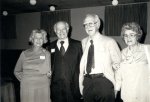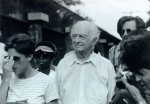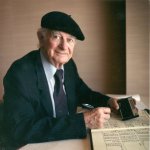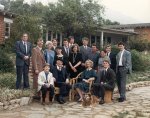
The Years Alone: Pauling after the Death of Ava Helen, Part 1 (1982-1988)
1982
In the late spring, Arthur Robinson continues to file legal actions against Pauling, members of the Board of Trustees, and the Linus Pauling Institute.
Pauling moves to an apartment on the Stanford campus, and his youngest son, Crellin, moves with his family from Riverside into his father’s Portola Valley house.
In June, Pauling takes a sentimental trip to Oregon and Washington to visit with family. He revisits several places where he and Ava Helen spent time together. He sees, for the first time, the grave of his grandfather Linus Wilson Darling in the Condon cemetery.

Lucile (Pauling) Jenkins, Linus Pauling, Paul Emmett and Pauline (Pauling) Emmett, 1982.
LP Photographs, 1982i.5
On September 24, Pauling receives the 1982 Distinguished Achievement Award of the American Aging Association at their Twelfth Annual National Meeting in San Francisco. Pauling’s address is entitled "Vitamins and Aging."
In October, Pauling is a principal speaker at the Fate of the Earth Conference in New York City.
1983
Pauling publishes the 25th Anniversary Edition of No More War!
In February, following extensive discussions of a host of concerns expressed by all parties, a decision is reached by the Linus Pauling Institute and Arthur Robinson to settle the litigation that followed his removal as President of the Institute. The out-of-court settlement becomes public in July. The Linus Pauling Institute agreed to pay its former president $575,000 to settle the five-year legal dispute over Robinson’s dismissal. Pauling says he settled because "it was cheaper than to continue" the legal wrangling. According to Pauling, the amount of the settlement represented compensation for Robinson’s loss of office and the cost of his legal fees. According to Robinson, the settlement was for libel and slander claims as well as reimbursement of attorney’s fees and costs. In the view of both sides, none of the parties admits liability. Shortly after the settlement with Pauling, Robinson brings a lawsuit against his former attorneys, alleging that he was forced to accept a settlement from the Linus Pauling Institute "too low in value as a result of an alleged abandonment by his attorneys."
The American Chemical Society announces in July that Pauling will receive its most prestigious award, the Priestley Medal, in 1984, for his important contributions to chemistry and to the programs and affairs of the American Chemical Society.
In November, Pauling announces his discovery of a new type of chemical bond that can mimic, for small molecules, the kind of bonding believed to exist in bulk metals. The new bond is found between two tin atoms in a molecule also containing carbon and silicon.
During the Winter Quarter, Pauling delivers the Charles M. and Martha Hitchcock Lectures at the University of California in Berkeley.
1984
On March 11, Pauling speaks on the nature of bonds formed by atoms of transition metals at the Cornell University celebration commemorating the hundredth anniversary of the birth of Peter J.W. Debye.
On July 24, Pauling flies to Panama City where he boards the Peace Ship, which sails for Nicaragua with a cargo of medicine, school supplies, fertilizers and other items to help in the peaceful development of the country. Pauling is one of four Nobel laureates (the other three are Adolfo Perez Esquivel, George Wald, and Betty Williams) and an international group of antiwar activists involved in this project.
At the end of September, Pauling is Chairman of a Symposium on Nutrition, Health, and Peace at The Stanford Court in San Francisco. The symposium is sponsored by Mr. Ryoichi Sasakawa of Tokyo, Japan.
1985
In January, the second Mayo Clinic study of cancer and vitamin C appears in The New England Journal of Medicine. Using patients not undergoing cytotoxic chemotherapy, the researchers find no improvement in cancer patients who have taken large supplements of vitamin C. On January 25, Pauling charges physicians in the Mayo Clinic with issuing a "false and misleading claim" that they had repeated the work of Dr. Ewan Cameron. He later claims that the article is "written in such a thoroughly misleading way as to justify my calling it fraudulent."
According to Pauling, the publicity from the Mayo Clinic study has "a bad effect on our Institute by decreasing contributions that we get." Shortly after taking care of their indebtedness to Robinson and their lawyers, members of the Linus Pauling Institute again experience financial hardship. Despite these setbacks, Pauling continues to battle for his idea of the beneficial health effects of large amounts of vitamin C, even though it is "hard for [him] to understand why there is so much resistance to this new idea, which in [his] opinion is the most promising innovation in the field of cancer that has been made in the last 20 years."
In April, Paul Emmett dies, and Pauling goes to Portland for the services.
In the summer, Pauling begins writing papers on "quasicrystals," and he attributes their apparent icosahedral symmetry to directed multiple twinning of cubic crystals.
1986
Pauling publishes How to Live Longer and Feel Better, a popular account of his ideas on nutrition and health. The book makes the New York Times best-seller list.
The Roots of Molecular Medicine: A Tribute to Linus Pauling, edited by R.P. Huemer, is published. Pauling writes on the future of orthomolecular medicine for this book.
Pauling and Zelek Herman publish an article, "The Nature of the Chemical Bond Fifty Years Later: The Relative Electronegativity of Atoms Seen in Perspective," in Molecular Structure and Energetics, Vol. 1, edited by J.F. Liebman and A. Greenberg.
1987
Pauling and Ewan Cameron begin to advocate the use of vitamin C in the treatment of AIDS.
Pauling publishes several papers on quasicrystals, proposing that the icosahedral and decagonal "quasicrystals" of manganese-aluminum and other alloys are in reality twinned cubic crystals.
Pauling receives the American Chemical Society Award in Chemical Education.
In November, Pauling delivers a special series of the George Fisher Baker Non-resident Lectures in Chemistry Commemorating the 1937 Lecture Series Entitled: "The Nature of the Chemical Bond." This lecture series at Cornell University draws overflow crowds and an enthusiastic response.
1988
Pauling continues to publish papers and letters on vitamin C and on quasicrystals.
He becomes interested in high-temperature superconductivity and writes a paper on the role of the metallic orbital and of crest and trough superconduction in high-temperature superconductors, which he presents at a conference held in April in Alabama.
In formulating his theory of superconductivity he conceives "a method of fabricating a composite containing filaments of a superconducting material with a diameter and cross-sectional shape such as to confer on the material improved properties, such as increase in the characteristic superconducting temperature."
So convinced is he of the value of his ideas on making a high-temperature superconducting wire that he applies for a patent and sets up a corporation, Superbio, Inc. The initial directors of this corporation are Pauling, Richard Hicks, and Emile Zuckerkandl. On August 26, Pauling becomes the registered holder of 300,000 shares in Superbio, Inc.
Table of Contents
- The Ancestry of Linus Pauling (The Paulings)
- The Ancestry of Linus Pauling (The Darlings)
- Linus Pauling's Childhood (1901-1910)
- Linus Pauling's Adolescence (1910-1917)
- Pauling's Years as an Undergraduate at Oregon Agricultural College, Part 1 (1917-1919)
- Pauling's Years as an Undergraduate at Oregon Agricultural College, Part 2 (1919-1922)
- Linus Pauling as a Graduate and Postdoctoral Student at the California Institute of Technology, Part 1 (1922-1923)
- Linus Pauling as a Graduate and Postdoctoral Student at the California Institute of Technology, Part 2 (1924-1926)
- A Guggenheim Fellow in Europe during the Golden Years of Physics (1926-1927)
- Early Career at the California Institute of Technology (1927-1930)
- Pauling's Great Years of Achievement in Structural Chemistry, Part 1 (1931-1932)
- Pauling's Great Years of Achievement in Structural Chemistry, Part 2 (1933-1935)
- Pauling's Increasing Involvement in Molecular Biology (1936-1939)
- The War Years, Part 1 (1940-1942)
- The War Years, Part 2 (1943-1945)
- The Postwar Years, Part 1 (1946-1947)
- The Postwar Years, Part 2 (1948-1949)
- Proteins, Passports, and the Prize (1950-1954)
- Increasing Involvement in World Peace, Part 1 (1955-1958)
- Increasing Involvement in World Peace, Part 2 (1959-1963)
- The Center for the Study of Democratic Institutions (1964-1967)
- The University of California, San Diego (1968-1969)
- Stanford University (1969-1972)
- An Institute for Science and Orthomolecular Medicine, Part 1 (1973-1977)
- An Institute for Science and Orthomolecular Medicine, Part 2 (1978-1981)
- The Years Alone: Pauling after the Death of Ava Helen, Part 1 (1982-1988)
- The Years Alone: Pauling after the Death of Ava Helen, Part 2 (1989-1994)
- About the Author




